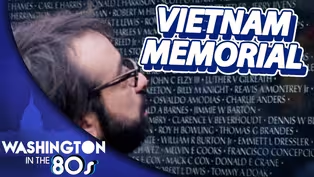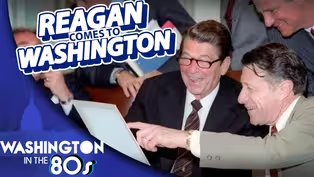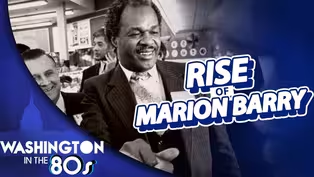
How the DC Theatre Scene Exploded in the 1980s
Clip | 2m 54sVideo has Closed Captions
In the 1980s, Washington's alternative theater scene exploded.
As empty spaces became available at affordable rates in the 1980s, local theaters like DC's Woolly Mammoth and DC's Studio Theatre sprang up on 14th Street, establishing it as the hub of alternative theater in the city. Initially met with skepticism, these theaters gradually won over the residents, and Washington began its ascent as a prominent theater destination in the United States.
Problems playing video? | Closed Captioning Feedback
Problems playing video? | Closed Captioning Feedback
Washington in the 80s is a local public television program presented by WETA

How the DC Theatre Scene Exploded in the 1980s
Clip | 2m 54sVideo has Closed Captions
As empty spaces became available at affordable rates in the 1980s, local theaters like DC's Woolly Mammoth and DC's Studio Theatre sprang up on 14th Street, establishing it as the hub of alternative theater in the city. Initially met with skepticism, these theaters gradually won over the residents, and Washington began its ascent as a prominent theater destination in the United States.
Problems playing video? | Closed Captioning Feedback
How to Watch Washington in the 80s
Washington in the 80s is available to stream on pbs.org and the free PBS App, available on iPhone, Apple TV, Android TV, Android smartphones, Amazon Fire TV, Amazon Fire Tablet, Roku, Samsung Smart TV, and Vizio.
NARRATOR: D.C.'s downtown areas received an additional boost in the '80s as a slew of local theaters opened their doors.
ARCH: These little companies started springing up because Downtown was so empty that they could get space cheap.
Uh, the Woolly Mammoth, uh, and the Studio Theatres opened on 14th Street.
14th Street sort of became the center of, uh, alternative theater.
NARRATOR: But at first, residents weren't convinced.
ARCH: I would go over there to watch some of their shows.
Uh, you know, 10, 15, 20 people in the audience, plus the actors.
NARRATOR: But in time, people's reluctance to come Downtown eased, and Washington began its rise to America's second city of theater.
ROBERT: Washington was like that.
I mean, it h- it had certain kinds of, um, cultural, uh, niches if you will.
HELEN: I'm a Washingtonian.
And the first, the first theater I ever saw was from the top balcony of the National.
NARRATOR: As Washington's theater scene gained country-wide attention, it established an award named in honor of one of the city's most acclaimed daughters to recognize local theatrical excellence.
ARCH: The great Washington Post critic, Richard Coe, uh, called on his friendship with Helen Hayes.
And together, they created The Helen Hayes Awards.
And once The Helen Hayes Awards started, more companies started popping up.
By the end of the decade, Washington was on the same playing field as, uh, Chicago.
NARRATOR: The region's growing interest in the arts was exploited by Washington's TV affiliates, still hungry for novel programming.
ARCH: The king of the critics in Washington D.C. was Davey Marlin-Jones.
Davey was one of the most interesting people I had ever met.
DAVEY: There may be something there.
ARCH: Davey wore hats.
He also pushed the envelope with his clothes.
He pushed his envelope in every way.
DAVEY: Tight, taught, tense.
ARCH: Davey owned this town.
DAVEY: Inside the theater called life.
NARRATOR: A popular format that encouraged imitation.
ARCH: Every station in town had a critic, and it was because we were all trying to compete with Davey.
It was one of the great gags of local television.
When he finished his report, you didn't know if he liked the movie or not.
DAVEY: Hope you find one cinematic sparkler among them.
Davey Marlin-Jones... NARRATOR: For more clips and to watch the full program visit weta.org/decades.
Video has Closed Captions
Clip | 1m 41s | Discover the vibrant bar and club scene in Washington, DC during the mid-1980s. (1m 41s)
What Made Maya Lin's Vietnam Memorial Design Controversial
Video has Closed Captions
Clip | 2m 3s | Explore the story of the Washington, DC's Vietnam Memorial. (2m 3s)
How Washington DC Reacted to Ronald Reagan
Video has Closed Captions
Clip | 3m 19s | When Ronald Reagan came into office in 1981, Washingtonians reaction was mixed. (3m 19s)
How the DC Theatre Scene Exploded in the 1980s
Video has Closed Captions
Clip | 2m 54s | In the 1980s, Washington's alternative theater scene exploded. (2m 54s)
How Marion Barry Transformed Black Political Power in DC
Video has Closed Captions
Clip | 3m 15s | The election of 1982 represented an important milestone in the career of Marion Barry. (3m 15s)
Providing Support for PBS.org
Learn Moreabout PBS online sponsorshipSupport for PBS provided by:
Washington in the 80s is a local public television program presented by WETA
















